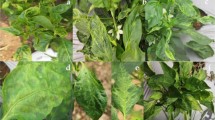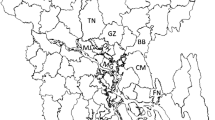Abstract
Chilli pepper is an important vegetable and spice crop grown worldwide. Chilli is susceptible to various pathogens, among them mosaic disease caused by Cucumber mosaic virus (CMV) is a major constraint for its production. Roving survey was carried out for mosaic disease assessment in chilli at 35 locations comprising five districts of south eastern Karnataka, which was later confirmed for the presence of different viruses in random samples by DAC-ELISA. Results revealed the prevalence of the disease caused by CMV up to 43.00% based on visual assessment. However, only in 64 samples out of 140 infected chilli samples showed CMV infection in DAC-ELISA and revealed the mixed infection of viruses. Mechanical sap inoculation of CMV-Ko isolate induced symptoms on chilli plants, which were similar to the symptoms observed in field. Complete genome sequence of CMV-Ko (RNA1, RNA2 and RNA3) isolate was amplified, cloned and sequenced. Sequence analysis revealed that it shared 83.7–99.1% nucleotide (nt) identity with CMV subgroup IB isolates infecting different crops in India. Recombination analysis of CMV-Ko genome showed that, RNA1 and RNA2 had recombinant origin and not RNA3. Host range studies for CMV-Ko isolate showed its potential of infecting nine host plants out of 21 used for transmission. Fifty advanced chilli lines were screened against CMV-Ko isolate and 27 immune lines to CMV were identified, which can be utilized for management of disease caused by CMV in chilli.




Similar content being viewed by others
References
Afreen B, Khan AA, Naqvi QA, Kumar S, Pratap D, Snehi SK, Raj SK. Molecular identification of a Cucumber mosaic virus subgroup II isolate from carrot (Daucus carota) based on RNA3 genome sequence analyses. J Plant Dis Prot. 2009;116:193–9.
Altschul SF, Gish W, Miller W, Mysers EW, Lipman DJ. Basal local alignment search tool. J Mol Biol. 1990;215:403–10.
ArliSokmen M, Mennan H, Sevik MA, Ecevit O. Occurrence of viruses in field grown pepper crops and some of their reservoir weed hosts in Samsun, Turkey. Phytoparasitica. 2005;33:347–58.
Beclin C, Berthome R, Palauqui JC, Tepfer M, Vaucheret H. Infection of tobacco or Arabidopsis plants by CMV counteracts systemic post-transcriptional silencing of non-viral (trans) genes. Virology. 1998;252:313–7.
Bidari VB, Reddy HR. A survey on mosaic viruses and their distribution in different chilli cultivars in Karnataka. Mysore J Agric Sci. 1994;28:52–9.
Boccard F, Baulcombe D. Mutational analysis of cis-acting sequences and gene function in RNA3 of Cucumber mosaic virus. Virology. 1993;193(2):563–78.
Conti M, Caciagli P, Casetta A. Infection sources and aphid vector in relation to the spread of Cucumber mosaic virus in pepper crops. Phytopathol Medit. 1997;18:123–8.
Devi O, Devi K. Viral diseases in king chilli a brief report. AgriCos e-Newsletter. 2020.
Doolittle SP, Walker MN. Cross inoculation studies with cucurbit mosaic. Sci Newsletter. 1923;57:477.
FAOSTAT. Food and agriculture organization of the United Nations. 2017. http://faostat.fao.org.
Galtier N, Gouy M, Gautier C. Sea view and Phylo win: two graphic tools for sequence alignment and molecular phylogeny. Comput Applic Biosci. 1996;12:543–8.
Grube RC, Elaine R, Radwanski JM. Comparative genetics of disease resistance within the solanaceae. Genetics. 2000;155(2):873–87.
Hareesh PS, Madhubala R, Bhat AI. Characterization of Cucumber mosaic virus infecting Indian long pepper (Peper longum L.) and betel vine (Piper betle L.) in India. Indian J Biotechnol. 2006;5:89–93.
Hobbs HA, Reddy DVR, Rajeshwari R, Reddy AS. Use of direct antigen coating and protein A coating ELISA procedures for three peanut viruses. Plant Dis. 1987;71:747–9.
Huson DH, Bryant D. Application of phylogenetic networks in evolutionary studies. Mol Biol Evol. 2006;23:254–67.
Jha A, Raychaudhuri SP. Mosaic disease of chilli (C. frutescens L.) Indian. J Agric Sci. 1956;26:217–22.
Kamińska M, Śliwa H, Malinowski T. Partial characterization of Cucumber mosaic virus isolate infecting Lonicera caprifolium L plants. Acta Sci Pol. 2005;4:3–10.
Khan SM, Raj SK, Bano T, Garg VK. Incidence and management of mosaic and leaf curl diseases in cultivars chilli (Capsicum annum L). J Food Agric Environ. 2006;4:171–4.
Kim MK, Seo JK, Kwak HR, Kim JS, Kim KH, Cha BJ, Choi HS. Molecular genetic analysis of Cucumber mosaic virus populations infecting pepper suggests unique patterns of evolution in Korea. Phytopathology. 2014;104:993–1000.
Kumar S, Stecher G, Li M, Knyaz C, Tamura K. MEGA X: molecular evolutionary genetics analysis across computing platforms. Mol Biol Evol. 2018;35:1547–9.
Kumari R, Bhardwaj P, Singh L, Zaidi AA, Hallan V. Biological and molecular characterization of Cucumber mosaic virus subgroup II Isolate causing severe mosaic in cucumber. Indian J Virol. 2013;24:27–34.
Lin HX, Rubio L, Smythe AB, Falk BW. Molecular population genetics of Cucumber mosaic virus in California: evidence for founder effects and reassortment. J Virol. 2004;78:6666–75.
Martin DP, Murrell B, Golden M, Khoosal A, Muhire B. RDP4: detection and analysis of recombination patterns in virus genomes. Virus Evol. 2015. https://doi.org/10.1093/ve/vev003.
Nagendran K, Priyanka R, Aravintharaja R, Balaji CG, Prashant S, Basavaraj B, Mohankumar S, Karthikeyan G. Characterization of Cucumber mosaic virus infecting snake gourd and bottle gourd in India. Physiol Mol Plant Pathol. 2018;103:102–6.
Naresh P, Krishna Reddy M, Hema ChandraReddy P, Madhavi Reddy K. Screening chilli (Capsicum spp.) germplasm against Cucumber mosaic virus and Chilli veinal mottle virus and inheritance of resistance. Eur J Plant Pathol. 2016;146:451–64.
Nono-Womdim R, Marchoux G, Pochard E, Palloix A, Gebre-Selassie K. Resistance of pepper lines to the movement of Cucumber mosaic virus. J Phytopathol. 1991;132:21–32.
Nouri S, Arevalo R, Falk BW, Groves RL. Genetic structure and molecular variability of Cucumber mosaic virus isolates in the United States. PLoSONE. 2014. https://doi.org/10.1371/journal.pone.0096582.
Owens J, Shintaku M, Aeschleman P, Tahar SF, Palukaitis P. Nucleotide sequence and evolutionary relationships of Cucumber mosaic virus (CMV) strains, CMV RNA 3. J Gen Virol. 1990;71:2243–9.
Palukaitis P, Roossinck MJ, Dietzgen RG, Francki RIB. Cucumber mosaic virus. Adv Virus Res. 1992;41:281–348.
Pavithra BS, Govin K, Renuka HM, Krishnareddy M, Jalali S, Samuel DK, Himabindu K. Characterization of Cucumber mosaic virus infecting coleus (Plectranthus barbatus) in Karnataka. VirusDis. 2019. https://doi.org/10.1007/s13337-019-00536-3.
Pratap D, Kumar S, Snehi SK, Raj SK. Biological and molecular characterization of Cucumber mosaic virus isolate causing shoestring disease of tomato in India which has closer affinity to European or East Asian isolates of CMV. Indian J Virol. 2012;23(1):57–63.
Rajamanickam S, Nakkeeran S. Molecular characterization of Cucumber mosaic virus infection in chilli (Capsicum annuum L.) and its phylogenetic analysis. Int J Chem Stud. 2020;8(4):2967–70.
Ravi KS, Joseph J, Nagaraju N, Prasad SK, Reddy HR, Savitri HS. Characterization of pepper vein banding virus from chilli pepper. Plant Dis. 1997;8:673–6.
Reddy MK, Srivastava A, Kumar S, Kumar R, Chawda N, Ebert AW, Vishwakarma M. Chilli (Capsicum annuum L.) breeding in India: an overview. SABRAO J Breed Gene. 2014;46:160–73.
Revathy KA, Bhat AI. Complete genome sequencing of Cucumber mosaic virus from black pepper revealed rare deletion in the methyltransferase domain of 1a gene. VirusDis. 2017;28:309–14.
Roossinck MJ, Zhang L, Hellward K. Rearrangements in the 5’ nontranslated region and phylogenetic analysis of Cucumber mosaic virus RNA 3 indicate radial evolution of three subgroups. J Virol. 1999;73:6752–8.
Roossinck MJ. Evolutionary history of Cucumber mosaic virus deduced by phylogenetic analyses. J Virol. 2002;76:3382–7.
Sevik MA. Natural occurrence of Cucumber mosaic virus infecting water mint (Mentha aquatica) in Antalyaand Konya. Turkey Acta Bot Croat. 2012;71:187–93.
Shi BJ, Palukaitis P, Symons RH. Differential virulence by strains of Cucumber mosaic virus is mediated by the 2b gene. Mol Plant Microbe Interact. 2002;15:947–55.
Shi BJ, Symons RH, Palukaitis P. The cucumovirus 2b gene drives selection of inter-viral recombinants affecting the crossover site, the acceptor RNA and the rate of selection. Nucleic Acids Res. 2008;36:1057–71.
Shukla DD, Ram S. Natural occurrence of three different viruses on chillies in Rajasthan. Indian J Mycol Pathol. 1977;7:122–6.
Silva CQ, Rodrigues R, Bento CS, Pimenta S. Heterosis and combining ability for ornamental chili pepper. Hortic Bras. 2017;35:349–57.
Soards AJ, Murphy AM, Palukaitis P, Carr JP. Virulence and differential local and systemic spread of Cucumber mosaic virus in tobacco are affected by the CMV 2b protein. Mol Plant Microbe Interact. 2002;15:647–53.
Sudhakar N, Nagendra-Prasad D, Mohan N, Murugesan K. First report of Cucumber mosaic virus subgroup II infecting Lycopersicon esculentum in India. Plant Dis. 2006;90:1457.
Tamarziztab HB, Montarryc J, Girardota G, Fakhfakhb H, Tepferad M, Jacquemonda M. Cucumber mosaic virus populations in Tunisian pepper crops are mainly composed of virus reassortants with resistance-breaking properties. Plant Pathol. 2013;62:1415–28.
Verghese J. Scanning paprika oleoresin and chilli colour specifications/quality parameters. Indian Spices. 1999;36:7–11.
Vinoth Kumar R, Singh AK, Singh AK, Yadav T, Basu S, Kushwaha N, Chattopadhyay B. Chakraborty S Complexity of begomovirus and betasatellite populations associated with chilli leaf curl disease in India. J Gen Virol. 2015;96:3143–58.
Wahyuni WS, Dietzgen RG, Hanada K, Francki RIB. Serological and biological variation between and within subgroup I and II strains of Cucumber mosaic virus. Plant Pathol. 1992;41:282–97.
Zehra SB, Ahmad A, Sharma A, Sofi S, Lateef A, Bashir Z, Husain M, Rathore JP. Chilli leaf curl virus an emerging threat to chilli in India. Int J Pure App Biosci. 2017;5(5):404–14.
Zhigila DA, AbdulRahaman AA, Kolawole OS, Oladele FA . Fruit morphology as taxonomic features in five varieties of Capsicum annuum L. Solanaceae. J Bot. 2017;1–6. http://www.hindawi.com/journals/jb/2014/540868.
Acknowledgements
The authors are grateful to the Director of Indian Institute of Horticultural Research, Bangalore and University of Agricultural Sciences, GKVK, Bangalore for providing research facilities and keen interest in this study.
Author information
Authors and Affiliations
Corresponding authors
Ethics declarations
Conflict of interest
All the authors declare that they have no competing interests.
Ethical approval
This article does not contain any studies with human or animal subjects performed by any of the authors.
Additional information
Publisher's Note
Springer Nature remains neutral with regard to jurisdictional claims in published maps and institutional affiliations.
Supplementary Information
Below is the link to the electronic supplementary material.
Rights and permissions
About this article
Cite this article
Ashwathappa, K.V., Krishna Reddy, M., Venkataravanappa, V. et al. Genome characterization and host range studies of Cucumber mosaic virus belonging to the Subgroup IB infecting chilli in India and screening of chilli genotypes for identification of resistance. VirusDis. 32, 535–547 (2021). https://doi.org/10.1007/s13337-021-00713-3
Received:
Accepted:
Published:
Issue Date:
DOI: https://doi.org/10.1007/s13337-021-00713-3




